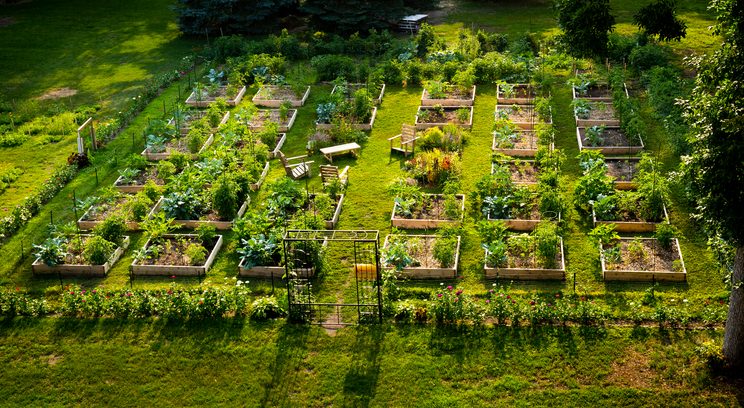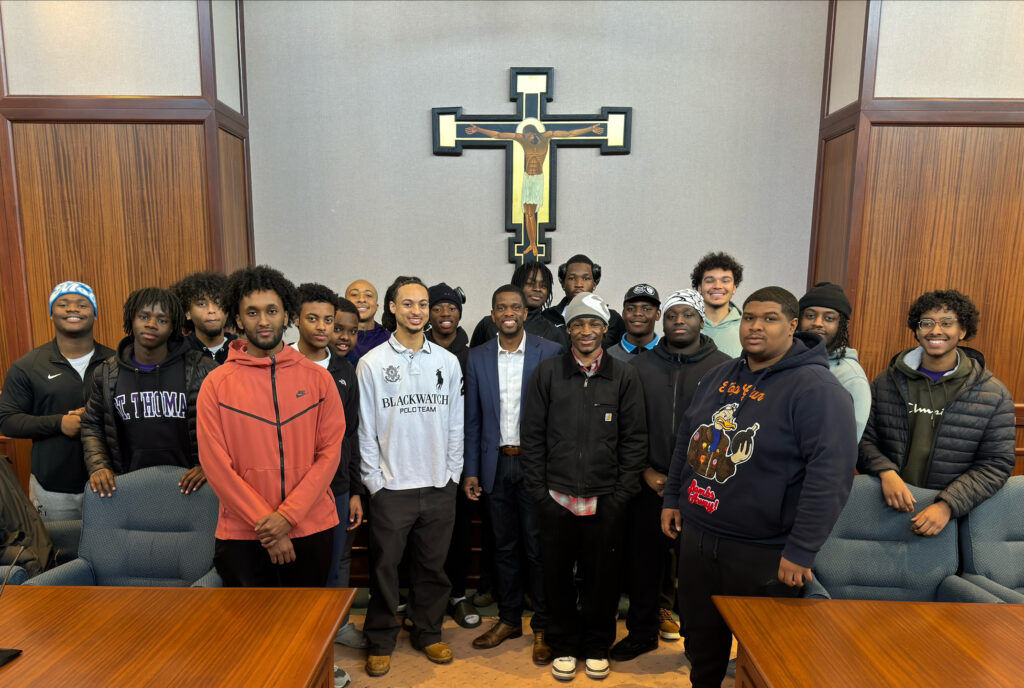Growing the Stewardship Garden
Since its inception in 2010, the UST Stewardship Garden has donated more than 4,000 pounds of vegetables to local organizations, allowed for in-depth student research, fostered positive neighbor relations and paved the way for wider Twin Cities community involvement.
Originally designed to be an experiment in biodiversity and organic fertilizers’ effect on crop yields, the garden has proven a success on both counts and has since taken root to expand its function, becoming equal parts sustainability, charity and scholarship.
Summer summary
Adam Kay, Ph.D., a St. Thomas biology professor who has overseen the project since the beginning, and the students working on the garden had a busy summer. Kay said the group discovered that mixed planting increased crop yield by 75 percent. Ashela Richardson ’13, who oversaw the garden during her time at St. Thomas, presented the findings at the Ecological Society of America meeting, attended by 3,000 people last summer in Minneapolis. One goal for the upcoming year is to prepare the information for publication.
The garden, roughly 80-by-80 feet, is located behind Brady Educational Center off Woodlawn and Goodrich avenues. Although anyone is welcome to come and help, the core five last summer consisted of students Leann Luecke, Liz Chambers, Hunter Gaitan, Taylor Schuweiler and Tyler Abrahamson ’13. According to Kay, the team did “all sorts of hard labor, all sorts of data collection, all sorts of service, and the reason that it looks so amazing out there is because of all their efforts.” The students do more than rote labor – they think up many of the projects themselves, feeding off each other’s enthusiasm and knowledge to collaborate on new ventures.
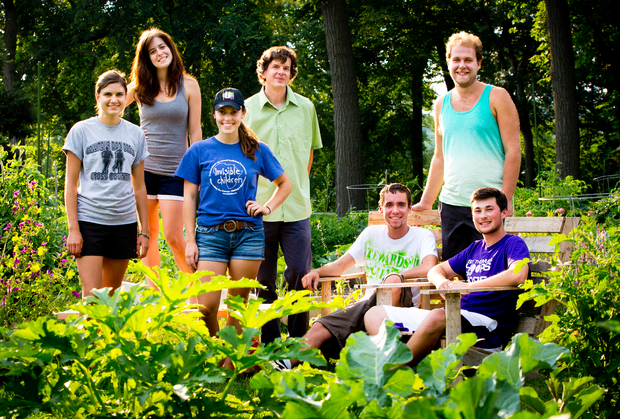
Left to right: Leann Luecke, Liz Chambers, Taylor Schuweiler, Professor Adam Kay, Tyler Abrahamson, Quinn Wrenholt and Hunter Gaitan all worked on the stewardship garden over the summer. Kay has overseen the project from the beginning. (Photo by Mark Brown)
Money the garden received from a Campus Sustainability Fund grant went toward building infrastructure at the garden in the form of establishing 32 cedar raised beds and bringing in soil to landscape the area: “We used that as a way of creating an environment where we could do experiments year after year, and we could do different treatments on the same location,” Kay said. “We can take the soil out, mix it up and return it. That’s a way of getting new students and doing new things on the site.”
Currently growing in the experimental plots are eggplant, broccoli, basil, zucchini, green beans, cilantro, potatoes, garlic, peppers and two types of tomatoes. The only thing growing outside these plots is cucumber. According to Luecke, the team also has planted Zinnias around the outside of the garden as well as some native plants in the center, which have brought on a wave of pollinators, particularly monarch butterflies.
The garden donates its produce to the food shelf Neighbors Inc. in South St. Paul. “They definitely value the fresh produce because a lot of their donations are can and box stuff,” Kay said. The garden has established a relationship with the organization over time: “We do events with them and they’ve come up here and visited. … They’re giving us advice as to what to grow depending on their clientele.”
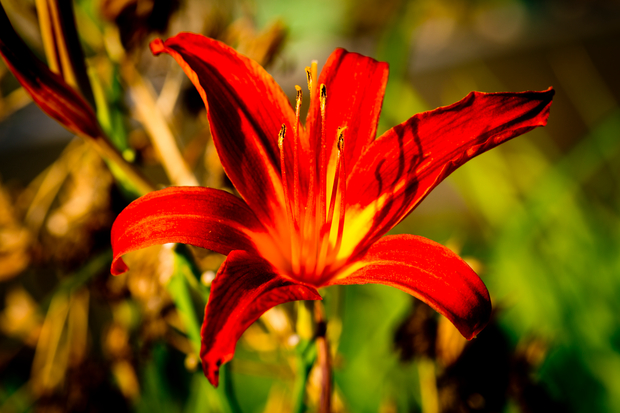
The garden doesn't just grow food. (Photo by Mark Brown)
Ongoing research projects
Luecke is heading up a two-year project examining the trade-offs between growing more food and lowering environmental impacts. Kay said, “If you just added more and more fertilizer to a site, you could increase vegetable production, but at the same time, the more fertilizer you add, the more it’s going to leech off, run off in the system and it’s going to get into the waterways. Our whole project is designed to try to find the sweet spot.”
In the first year of the project, the 2013 planting and harvesting season, students worked on finding the point where the diminishing returns on yield from increasing fertilizer start falling off. In the upcoming second year, taking place in 2014, they plan to set up a competition and invite personalities from across campus, including deans, department heads and student leaders, to look after their own individual plots and make decisions as to how much fertilizer should be applied, how much water is needed, what sort of crops should be grown and what sort of mulching should be done, so they can experience finding this sweet spot firsthand.
The other major project housed at the garden is the composting of recycled coffee grounds from across campus by red wiggler worms in six of the plots, generated by greenhouse manager and compost coordinator Chester Wilson and Quinn Wrenholt ’13. “The worms eat the coffee, and their castings and waste products are potential fertilizer, so we use those in these plots and test how the yield compares to the fertilizer plots,” Kay said.
Anyone who’s passed by the garden recently may have noticed the addition of some beautiful blooms. Not there just to look pretty, these wildflower species are a combination of phytoremediators and native Minnesota wildflowers and are serving as a two-year side project called Helpful Flowers, led by Chambers and Gaitan. The goal is to discover whether the mixture of wildflower species will aid in taking up heavy metals from contaminated soils. “There’s evidence that when you have mixed plantings, you can increase the uptake of nutrients from soils and you can increase the general productivity in the system. We want to see if that same pattern will also result in greater heavy metal uptake from the soil,” Kay said. The process is called fighter remediation. Future plans include taking the experiment to lots around St. Paul.
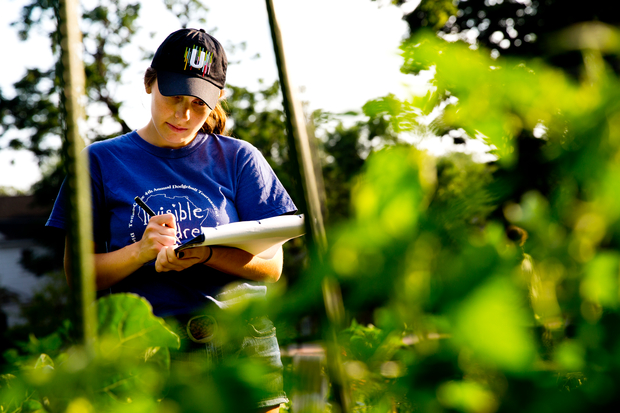
Taylor Schuweiler records data about the garden. (Photo by Mark Brown)
Involvement across campus
Aside from those directly involved in growing and grooming the garden, biology and environmental science students doing research also frequent the plot. Kay added that classes spanning the spectrum of departments sometimes work with the garden. These have included biology, geology, theology, English, science writing and, starting this year, communication and journalism class of professor and environmental writer Mark Neuzil, who has had a unique role in assisting the garden.
“We’d collected a lot of pallets to make raised beds for the wildflowers, but it just wasn’t the best use for our sources. We had this really awesome collaboration with Mark – he has a lot of carpentry skills because his dad was a shop teacher,” Chambers said. Neuzil, Chambers and Luecke built a bench and Adirondack chairs out of the old pallets, adding an aesthetically pleasing touch to the garden and replacing some previously salvaged plastic chairs.
Neighbor approval
The garden has been bolstering neighbor relations since its first year, and the positive reception has only continued to increase. “The neighbors were very curious when we expanded the garden, when we planted the Helpful Flowers plots, but now every time I’m out there, someone pretty much compliments them,” Chambers said. She also mentioned the neighbors like using the space around the garden to walk their dogs, play with their kids and sometimes have soccer practice. Luecke and Chambers have gone door to door to talk to the neighbors about the garden and the students invited neighbors to events earlier this summer to explain their projects. A brightly painted yellow mailbox stands at the entrance of the garden, stocked with information.
Plans for the year
The team plans to launch another project they’re calling Growing Science. They hope to take the Stewardship Garden set-up to St. Paul lots to construct raised beds, grow vegetables and test hypotheses. St. Thomas students will take the lead on managing the individual plots and pair up with local high schoolers to set up the site, develop it and collect data. “We can help people learn how to do science, but at the same time we can generate a lot of vegetables for the community,” Kay said.
Luecke, Chambers and Hunter, whose projects are in their second year, hope to complete them by the end of the next growing season, around the end of next September or beginning of October. The garden also will be expanding the size of its team significantly, allowing for more innovation and collaboration. “The thing that’s so cool about urban agriculture is that, it doesn’t take incredible technical expertise to do some of this stuff, but it does then create opportunities for people to be creative and ambitious,” Kay said.
